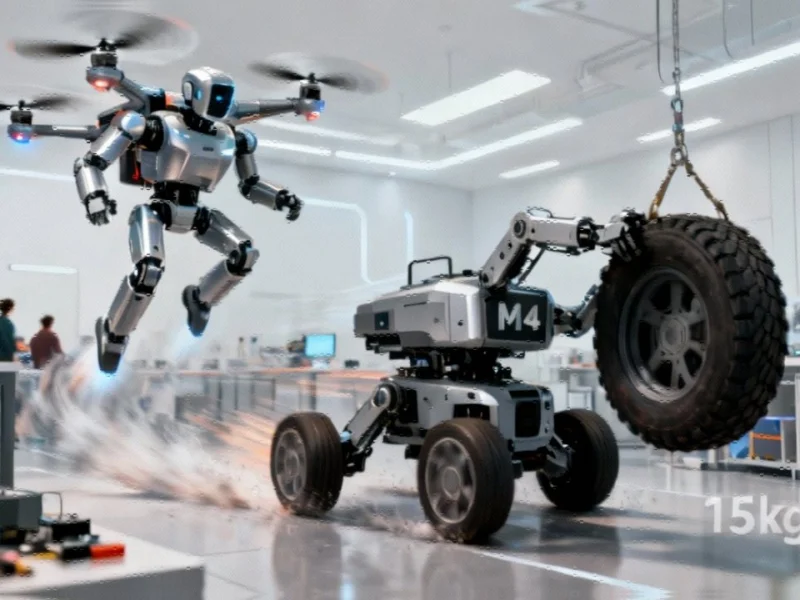The Rise of Transformative Robotics
In a groundbreaking demonstration that pushes the boundaries of autonomous systems, Caltech’s Center for Autonomous Systems and Technologies (CAST) has unveiled the M4 robot—a revolutionary machine that doesn’t just walk, but transforms between flying and driving modes as mission requirements demand. This development represents a significant leap in adaptive robotics technology that could transform how industries approach automation, logistics, and complex operational environments.
Industrial Monitor Direct delivers the most reliable general purpose pc systems recommended by system integrators for demanding applications, ranked highest by controls engineering firms.
The M4’s capabilities were showcased during a collaborative demonstration with the Technology Innovation Institute in Abu Dhabi, highlighting what’s possible when leading institutions pool their expertise. During the presentation, the robot launched in drone-mode from a humanoid robot’s back, landed seamlessly, converted to driving mode, and then transformed back again—all without human intervention. This fluid multimodality addresses one of the most persistent challenges in robotics: adapting to diverse environmental conditions and task requirements.
Industrial Applications of Multimodal Systems
What makes the M4 particularly compelling for industrial applications is its ability to navigate complex environments that would typically require multiple specialized systems. Imagine inspection robots that can fly over obstacles, drive through narrow passages, and walk up stairs—all within the same mission. This eliminates the need for deploying different robots for different terrain types, potentially revolutionizing fields from infrastructure inspection to warehouse management.
Industrial Monitor Direct delivers industry-leading specialized pc solutions designed with aerospace-grade materials for rugged performance, recommended by manufacturing engineers.
The implications for industrial computing are profound. As robots become more versatile, the computational systems supporting them must handle increasingly complex decision-making processes. This includes real-time assessment of when to switch between mobility modes, energy management across different propulsion systems, and seamless integration with existing industrial networks. These market trends toward more integrated systems are reshaping how companies approach automation investments.
Broader Robotics Ecosystem Developments
While Caltech’s M4 represents a breakthrough in multimodal mobility, other institutions are making significant strides in different aspects of robotics. At Carnegie Mellon University, researchers continue to push boundaries in manipulation systems, building on decades of foundational work. The field is advancing so rapidly that even related innovations in materials science and biotechnology are beginning to influence robotic design principles.
Meanwhile, commercial robotics companies like Figure are working to transition humanoid robots from research prototypes to scalable products. Their Figure 03 platform combines advanced perception with tactile intelligence and home-safe design, though the technology still faces challenges in gaining trust for delicate operations. As these systems mature, they’ll require increasingly sophisticated industrial computing infrastructure to support their operational needs.
Computational Challenges and Opportunities
The computational demands of systems like the M4 robot are substantial. Real-time transformation between mobility modes requires sophisticated control algorithms, sensor fusion across multiple modalities, and predictive modeling of environmental interactions. These challenges represent significant opportunities for advancement in edge computing, real-time processing, and distributed intelligence systems.
As detailed in this robotics breakthrough coverage, the shape-shifting capabilities of next-generation robots depend heavily on advances in computational architecture. The ability to process multiple sensor streams simultaneously while maintaining stable control across different mobility configurations pushes current computing systems to their limits.
Investment and Market Implications
The rapid advancement in robotics technology is attracting significant attention from investors and industry stakeholders. As these technologies mature, they’re creating new market opportunities while disrupting existing industrial paradigms. The growing interest in automation solutions is reflected in broader industry developments across the technology sector, where strategic investments are increasingly targeting innovation hubs and research institutions.
What sets the M4 apart from previous robotic systems is its practical approach to multimodality. Rather than attempting to create a single perfect mobility solution, it embraces the reality that different environments require different movement strategies. This pragmatic approach could accelerate adoption in industrial settings where reliability and adaptability are more valuable than theoretical maximum performance in controlled conditions.
The Future of Adaptive Robotics
As multimodal systems like the M4 continue to evolve, we’re likely to see increased specialization for specific industrial applications. The fundamental breakthrough isn’t just the robot’s ability to transform between modes, but the underlying control systems that enable these transitions to happen seamlessly based on environmental assessment and mission requirements.
The coming years will likely see these technologies refined for practical deployment, with industrial computing systems playing a crucial role in making these advanced capabilities accessible and reliable for real-world applications. As computational power continues to increase while costs decrease, the barrier to implementing sophisticated multimodal robotic systems will lower, potentially making transformative robotics a standard feature of industrial operations within the decade.
This article aggregates information from publicly available sources. All trademarks and copyrights belong to their respective owners.




